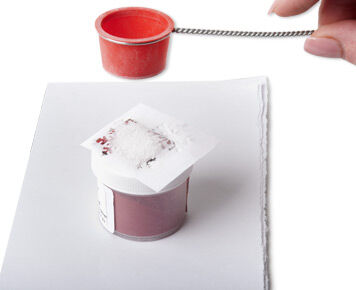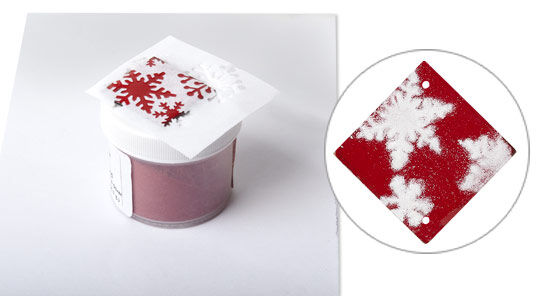Dry Sifting Enamel
Dry sifting is a versatile and effective technique in enamel jewelry making, allowing artisans to create intricate designs with a fine layer of enamel powder. Whether you're aiming for a smooth, even coat or looking to experiment with patterns and textures, mastering dry sifting can open a world of creative possibilities. In this article, we'll explore two methods of dry sifting—wet paper stenciling and sgraffito—to help you achieve stunning, professional results in your enamel work.
Wet Paper Stenciling
Wet Paper Stenciling Instructions

Draw or trace a pattern onto copy paper, brown craft paper or brown paper towels. Cut out the pattern using scissors or a craft knife; as an alternative, punch out the design using paper punches.
Add a counter enamel layer and a top layer to your metal. View Applying a Counter Enamel and Top Coat of Glass Enamels illustrated instructions for more information.

Wet the paper stencil, squeeze out the excess water then carefully place it onto the front of an enameled blank.

Place the blank onto a support so it is raised off your worksurface. Choose a color of enamel that contrasts with the color already enameled on the blank. Then sift a layer onto the stencil.

Carefully lift the stencil off the blank, trying hard not to shift the paper as you lift it. Any excess motion might cause enamel to fall through the openings onto your stenciled blank.
Check the surface. If needed, clean off the blank, brushing the wet enamel onto a scrap piece of paper and try again.
If you are happy with the stencil, carefully transfer the blank to a trivet, then allow any remaining moisture to dry. Once dry, place the trivet into the kiln or onto a tripod and fire. Remove once fired to your liking and allow to cool to room temperature.

Tip: It may be possible to reuse the stencil. Allow the paper to dry, then assess its condition. You can allow the excess wet enamel to dry and use it throughout your project. However, keep the wet enamel separate from the main container of enamel, then discard any leftover once your project is complete. Enamel that gets wet will degrade over time, and if returned to the enamel container it could contaminate the "good" enamel, affecting the overall look of your enamel at a later time.
Sgraffito (skrah-fee-toh) is an Italian word that relates to the technique of scratching through the top surface to see the layer below. This technique provides a great way to create patterns and unique effects on an enameled surface.
Sgraffito Instructions

Prepare your metal with a counter and top layer of enamel.

Place a trivet onto a folded wire mesh rack and set it aside within arm's reach.
Fill a sifter about 1/3 full of a color of enamel that contrasts with the color of the top layer. While holding your work over a piece of paper, sift a layer of enamel onto the front side.

Using a tool with a fine point or a fine-tipped artist's quality paintbrush, "scratch" out a pattern in the dry enamel.
Carefully place the blank onto the trivet. If needed, use a beading awl or toothpick to clean any stray enamel.

Fire the piece in a kiln or with a torch. Allow the piece to cool to room temperature before touching it.
Fold the paper to form a funnel-like spout then pour the excess enamels back into the container.
If needed, repeat. If needed or you would like, stone the edges with an alundum stone.
Mastering the techniques of dry sifting, such as wet paper stenciling and sgraffito, can significantly enhance your enamel jewelry designs. These methods offer endless creative possibilities, allowing you to achieve both precision and artistry in your work.
Have a question regarding this project? Email Customer Service.
Copyright Permissions
All works of authorship (articles, videos, tutorials and other creative works) are from the Fire Mountain Gems and Beads® Collection, and permission to copy is granted for non-commercial educational purposes only. All other reproduction requires written permission. For more information, please email copyrightpermission@firemtn.com.
Using a wet paper stencil with dry sifted enamel creates a striking and unique effect in jewelry making. As the enamel powder is carefully sifted over the damp stencil, it adheres to the specific design areas, resulting in crisp, defined patterns that stand out against the metal surface. Once fired, the contrast between the vibrant enamel and the metal base becomes even more pronounced, giving the piece a visually dynamic and almost three-dimensional appearance. This technique not only adds precision to your designs but also introduces a cool, textured look that elevates the overall artistry of your jewelry.

